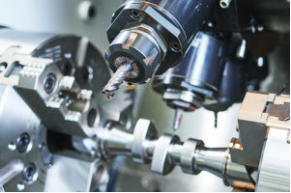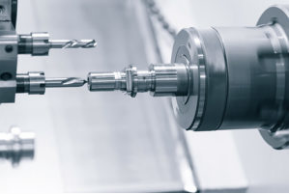Hotest Articles
Learn how advanced manufacturing processes like CNC machining enable the production of precision, lightweight components for the aerospace industry.
Worth over $800 billion, the global aerospace industry is ripe with innovation and is consistently at the cutting edge of new manufacturing practices and technologies. One of the most important factors when producing parts for aircraft or related systems is, of course, safety.
Whether working on a commercial, military or space-related project, all aircraft components—from the smallest interior detail to the plane’s engine—must be up to the highest standard. Because—as we know all too well—there is no room for human error in the production and assembly of aircraft, and any flaws or inconsistencies can have devastating effects.
The extremely high level of precision needed within the aerospace industry has made CNC machining a suitable manufacturing process for the sector, as it is capable of achieving very tight tolerances for metal and plastic parts.
Importance of precision in aerospace
Using state-of-the-art CNC machining equipment, qualified manufacturing services such as RapidDirect can produce aerospace prototypes and end use components for aerospace companies.
Working with aerospace-grade metals and plastics, CNC machine systems can reach tolerances up to 0.002 mm. Further, sophisticated post-processing and inspection systems can ensure that finished aerospace prototypes and parts are exactly up to standard. Unlike other industries, where tight tolerances might not be required for every part or assembly, the aerospace industry requires that dimensions, tolerances and performance are the tightest and highest possible so that parts do not fail in flight.
What materials are aerospace companies working with?
Though it is common to immediately think of an aircraft’s engine or wings when talking about aerospace manufacturing, there are millions of parts that make up an aircraft. The Boeing 747, for instance, is made up of over 6 million components. Evidently, not all the parts are produced using CNC machining, but even among those that are, there are several materials utilized in an aircraft assembly.
Lightweight Metals
The CNC machining materials used by aerospace companies are dictated by two key properties: strength and weight. Though strong, metals such as steel are not ideal for most parts because they are incredibly heavy—which leads to less fuel efficient (and thus more expensive) planes.
The aerospace industry has therefore been drawn to strong and lightweight metals such as titanium and aluminum alloys—both of which are machinable. Titanium, for instance, is roughly 30% stronger and 50% lighter than steel. It also boasts excellent resistance to high temperatures and corrosion, making it ideal for functional aircraft components and external parts.
Aluminum, for its part, is lighter than titanium but only about half as strong. The highly machinable metal is, however, more cost effective than titanium and is well suited for a wide range of aircraft components.
High-Performance Plastics
Though metal components are largely used for an aircraft’s functional structures, many interior components are made from polymer-based materials, as they are significantly more lightweight than metals. Parts such as interior wall panels, ventilation ducts, aircraft doors, wiring conduits, bearings and more are made from aerospace-grade plastics, which are lightweight, strong and meet aerospace fire retardant regulations.
CNC Machining is used to create strong, lightweight and complex plastic parts for the aerospace industry, from such materials as PEEK and other high-performance polymers. Similar to working with metals, CNC machining offers the high precision needed for polymer-based aerospace applications.
Aerospace applications for CNC Machining
Considering that an aircraft is made up of millions of components, it is not surprising that many manufacturing methods are used in their production: from sheet metal fabrication and molding to advanced manufacturing processes like 3D printing and CNC machining.
Within the scope of CNC machining, 5-axis machining is commonly used for the production of complex aircraft components, as it allows for parts to be milled, drilled and manipulated along the X, Y, Z and linear axes simultaneously without having to reconfigure or refixture the part. Why is complexity an asset in the aerospace sector? In short: weight. Being able to produce a part with a partially hollowed out or complex geometry can reduce its weight without sacrificing quality or performance.
Paired with sophisticated design and workflow software and state-of-the-art inspection processes, CNC machines can produce end-use parts and high quality tooling components for aerospace manufacturers. Though it would be impossible to list all the parts that are produced using CNC machining, some significant examples include hydraulic manifolds, transmissions, fuel bodies, landing gear, electrical connectors, housings and more.
CNC machining doesn’t only have an important role in the production of aircraft end-use parts; it plays a key part in aerospace R&D, enabling aerospace companies—big or small—to rapidly iterate new component designs, test them and, if needed, edit them. Rapid prototyping services such as RapidDirect can work with aerospace companies and OEMs to deliver CNC machined prototypes and parts within as little as three days with tolerances down to 0.002 mm.






